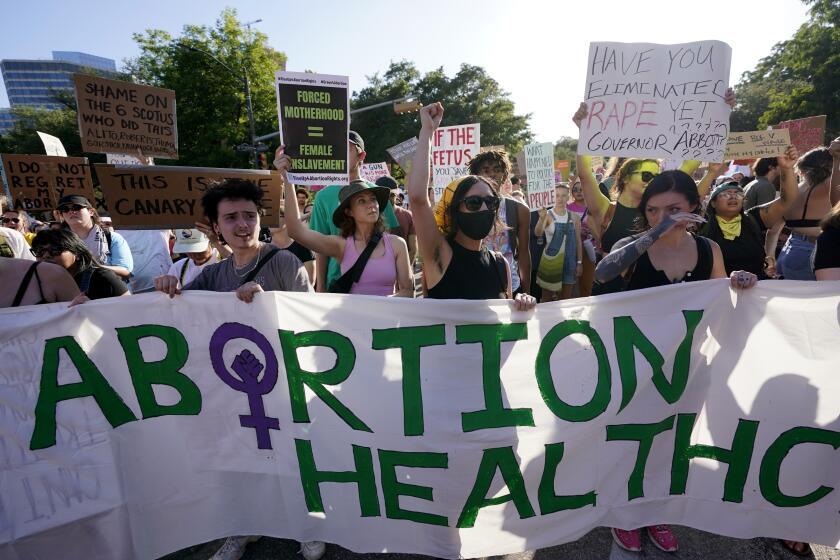This Supreme Court decision should be easy — keep medication abortion accessible

- Share via
The fate of the most commonly used abortion method in the U.S., and a prime target of antiabortion politicians and activists, is now in the hands of the U.S. Supreme Court. In 2022, the court took away the constitutional right to abortion by overturning Roe vs. Wade and created a chaotic patchwork of abortion access in this country.
Now the issues before the court involve the most commonly used abortion method — medication abortion with the drug mifepristone — and whether the U.S. Food and Drug Administration has final authority to make its own rules and regulations governing drugs. The Supreme Court should emphatically declare that mifepristone is safe to use under current FDA protocols and that the agency has authority to make that decision.
Abcarian: Who will make abortion pill rules? A bunch of right-wing judges, or FDA scientists?
The Supreme Court’s mifepristone case comes down to science and the health of women versus rabidly antiabortion hogwash.
It’s absurd that the efficacy of medication abortion is in question at all. The two-drug regimen of mifepristone followed by misoprostol has been used for 23 years by millions of people to end their pregnancies successfully and safely. It accounts for more than half of the abortions in the U.S., and serious complications occur in less than one-third of 1% of uses. Mifepristone is used mostly for abortion. Misoprostol is prescribed for other uses. Planned Parenthood Los Angeles operates 24 health clinics across L.A. County and estimates that roughly 60% of the 20,000 abortions they did this year were medication abortions.
A year ago, an alliance of antiabortion groups and doctors sued the federal government, claiming the FDA did not adequately study the drug, mifepristone, before authorizing it for use in 2000, and arguing that it is dangerous. Neither assertion is true. But the lawsuit was filed in a federal district court in Amarillo, Texas, where the presiding judge, Matthew J. Kacsmaryk, is an opponent of abortion. The judge ruled in April that the FDA’s authorization of mifepristone should be suspended, which would have taken it completely off the market in the U.S. The Supreme Court put that decision on hold while the case made its way through the appeals process.
When the Supreme Court overturned this ruling last year, it sent the issue of reproductive rights to the states, where the fight over access has been waged ever since -- and will continue into coming years.
A three-judge panel of the 5th Circuit Court of Appeals ruled in August that mifepristone could stay on the market — but under the stricter rules governing its use that were in place before 2016. The FDA appealed to the Supreme Court, which agreed this month to hear the case.
It’s possible the court will simply rule that the antiabortion alliance that brought the suit didn’t have standing and dismiss the case. That decision would leave open the possibility that more abortion opponents will pop up, arguing they have standing to sue.
State and local officials are trying to concoct new ways to block abortion funds, private nonprofits that help people travel to states that still provide abortion care.
But there are worse outcomes. The court could decide that mifepristone should not be on the market at all. (Legal experts don’t expect the court will do that.) Or they could uphold the 5th Circuit decision, which would reduce the window for taking the medication to seven weeks from 10 weeks and would change current dosages. In 2016, the dose of mifepristone was decreased and the misoprostol was increased. Returning to old dosage levels could result in more incomplete abortions, requiring more medication or other medical intervention.
We hope the Supreme Court avoids restricting medication abortion on a national level because it interferes with the provision of abortion in states where it is legal. And returning to the pre-2016 restrictions, which neither the FDA nor the American College of Obstetricians and Gynecologists believes are necessary, only hampers vital access in the states where abortion is available.
In the topsy-turvy world of conservative America, only this amoral figure can deliver the moral victory that the antiabortion movement craves.
When medication abortion first became available, it could only be prescribed by a doctor up to seven weeks of pregnancy, before many people even know they are pregnant. And getting it required three doctor’s appointments. Today, no in-person visit is required by the FDA (although some clinics require in-person visits), appointments can be done through telehealth, the pills can be mailed to a patient and the procedure is approved for up to 10 weeks of pregnancy. Other trained healthcare professionals besides medical doctors are also allowed to oversee medication abortions.
It’s possible that providers would use their discretion to prescribe abortion pills up to 12 weeks off-label or to change the dosages back to the current standard if the Supreme Court upholds the 5th Circuit’s ruling. But doing so might leave providers open to lawsuits in a highly charged political environment.
Sue Dunlap, president and chief executive of Planned Parenthood Los Angeles, calls the legal effort to put more restrictions on medication abortion yet another “concerted effort to criminalize abortion in this country.”
It’s ridiculous that abortion opponents and judges are second-guessing the FDA and trying to restrict healthcare professionals from offering the best standards of care in their quest to strip Americans of their reproductive rights. The Supreme Court must follow the science and leave it to regulators and healthcare providers to decide the best use of mifepristone.
More to Read
A cure for the common opinion
Get thought-provoking perspectives with our weekly newsletter.
You may occasionally receive promotional content from the Los Angeles Times.













